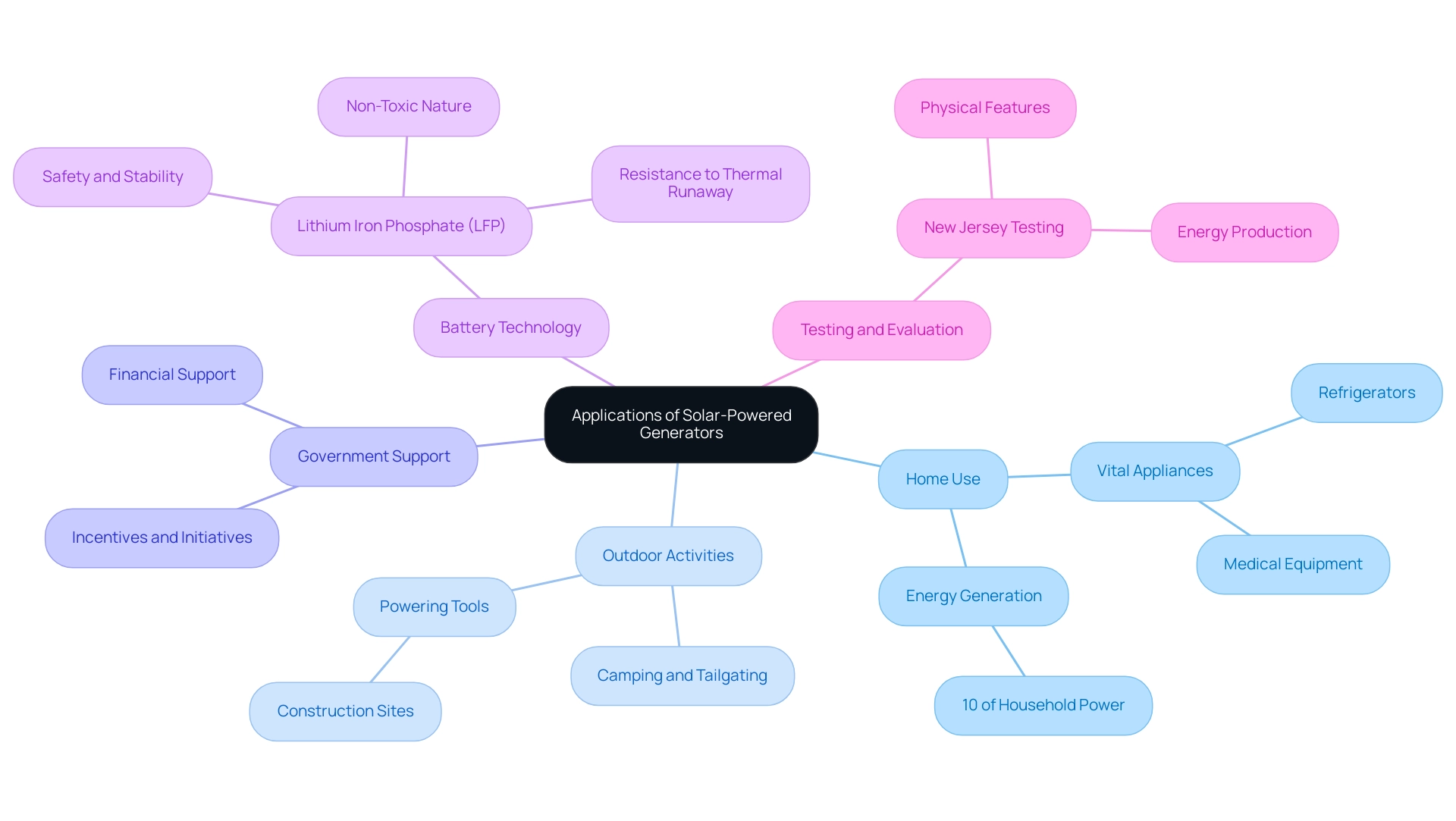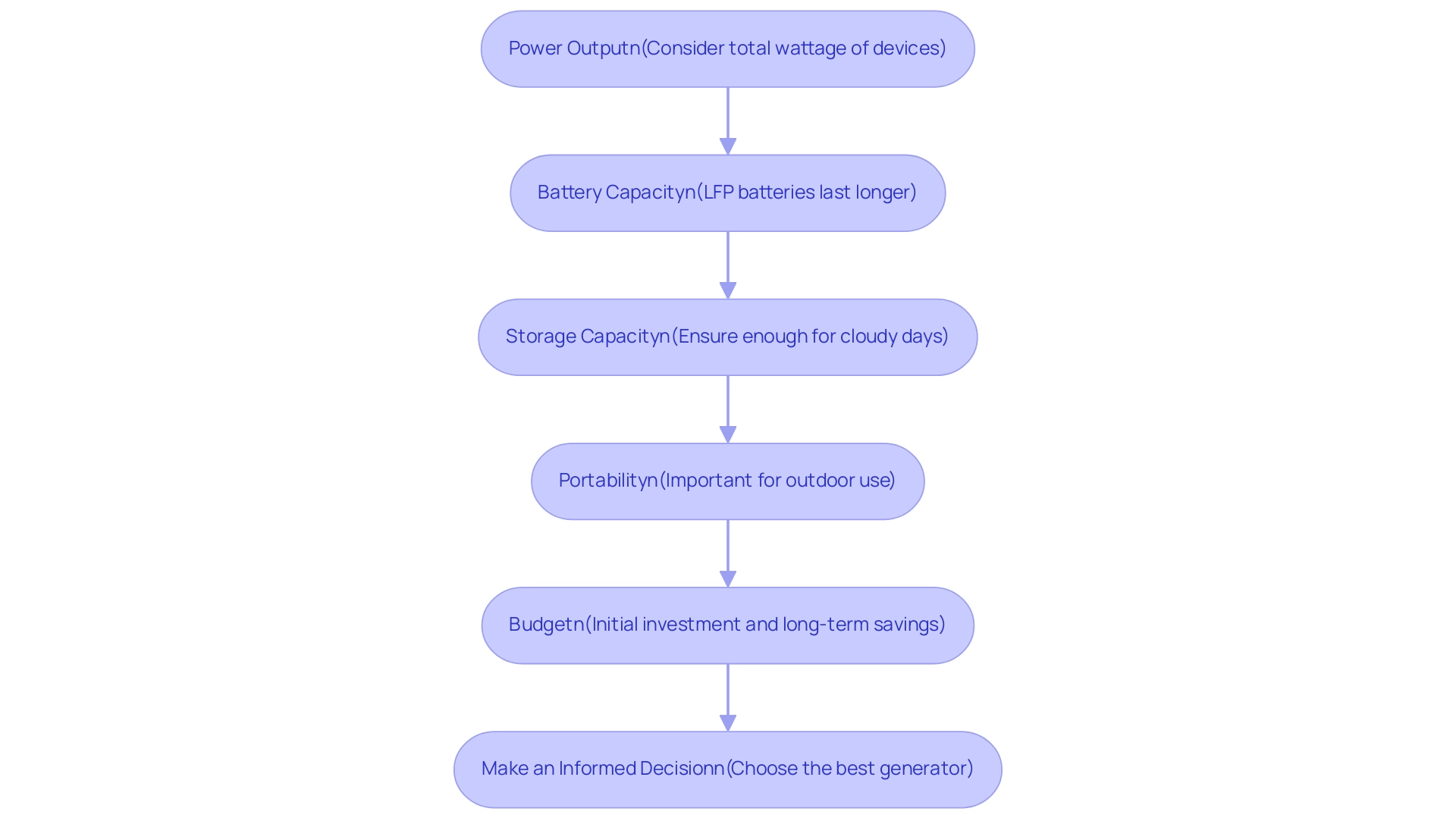Introduction
As homeowners increasingly seek sustainable solutions, solar-powered generators are emerging as a game-changer in energy independence and eco-friendliness. These innovative systems harness the sun’s energy, providing a reliable power source for everything from essential appliances during outages to outdoor adventures.
With advancements in technology, such as enhanced solar panels and efficient battery systems, the appeal of going solar has never been greater. This article delves into the components, advantages, applications, and tips for choosing the right solar-powered generator, empowering homeowners to make informed decisions that benefit both their wallets and the planet.
Embracing solar energy not only contributes to a cleaner environment but also paves the way for a more self-sufficient lifestyle.
Understanding Solar-Powered Generators: An Overview
A solar powered generator with solar panels is a groundbreaking system that converts sunlight into electrical power, making it ideal for supplying your home during outages or off-grid excursions. In contrast to conventional machines that rely on fossil fuels, these environmentally friendly systems harness renewable power via photovoltaic panels. At their core, a solar powered generator with solar panels includes:
- Photovoltaic panels
- A charge controller
- Storage units for retaining power
- An inverter that transforms direct current (DC) into alternating current (AC)
This setup makes it ideal for running household appliances, from your fridge to your laptop. By adopting a solar powered generator with solar panels, homeowners not only lessen their reliance on non-renewable resources but also contribute to a cleaner, more sustainable power future. With recent advancements in photovoltaic technology, such as Bluetti’s first-generation sodium-ion cell recognized for its thermal stability and rapid charging capability, and an increasing number of homeowners choosing renewable solutions, there’s never been a better time to consider going green.
Moreover, comprehending the significance of storage capacity and power ratings is vital for efficient home resource management and sustainability. As the U.S. imported over 3 GW of photovoltaic cells in Q2 2024, the market for this technology continues to grow, with recent utility-scale prices ranging from $16/MWh to $35/MWh. This makes renewable energy increasingly competitive with fossil fuels, reinforcing the case for eco-conscious homeowners to explore the best energy storage options for efficient use.
For instance, devices such as the Tesla Powerwall and LG Chem RESU are highly recommended for their efficiency and reliability. Additionally, maintaining the efficiency of your photovoltaic panels is essential; using eco-friendly cleaning solutions, such as a mixture of vinegar and water or specialized biodegradable cleaners, can help keep your panels in optimal condition without harming the environment.
Key Components of Solar-Powered Generators
A sunlight-powered device is an impressive system made up of several essential elements:
- Panels
- A charge controller
- Batteries
- An inverter
Solar panels are the heart of the generator, capturing sunlight and converting it into electricity. According to recent estimates, advancements in panel technology are pushing efficiencies to new heights, with some panels reaching over 22% efficiency in 2024.
Additionally, the energy tax credit is set to lower to almost 26% in 2033, offering significant financial incentives for potential buyers. Once the power is collected, the charge controller plays an essential role by managing the voltage and current from the photovoltaic panels, ensuring that the batteries do not get overcharged, which could harm them. Barry Elad, a senior writer in the renewable energy sector, points out, ‘About 90% to 97% of photovoltaic power material is recyclable and can be reused for other purposes when it breaks down.’
This highlights the sustainability aspect of photovoltaic technology. Access to backup power was the primary reason homeowners installed energy storage systems in 2023, highlighting the practical benefits of a solar powered generator with solar panels. When choosing a solar power storage unit, it’s vital to consider key factors such as:
- Capacity
- Efficiency
- Lifespan
- Price
For example, the Bluetti EP900, recognized for its modular design, provides a capacity of up to 9 kWh and an efficiency rating of 95%, making it a dependable option for independence. The energy cells then retain this generated power for those cloudy days or nighttime use, providing homeowners with dependable backup energy. Finally, the inverter converts the stored DC electricity into AC electricity, which is essential for running most household appliances.
Furthermore, the global manufacturing capacity of solar PV is projected to reach nearly 1,000 GW in 2024, showcasing the growth and advancements in the solar industry. By understanding these components and their functions, along with the best practices for selecting batteries, including tips on installation such as ensuring proper ventilation and following manufacturer guidelines, homeowners can truly appreciate the efficiency and functionality of solar-powered systems, paving the way for a greener lifestyle.
Advantages of Solar-Powered Generators
Eco-conscious homeowners are finding that a solar powered generator with solar panels is becoming increasingly popular, and for good reason. They not only promote environmental sustainability by reducing reliance on fossil fuels but also lead to significant cost savings. For example, using sunlight power can significantly reduce electricity costs, especially in sunny regions such as California, where utility prices can skyrocket.
Homeowners can expect notable reductions in their monthly expenses by tapping into this renewable resource.
Numerous case studies reinforce these benefits. For instance, a household in Southern California realized over 70% savings on their utility costs by installing a photovoltaic water heating system combined with a heat exchanger, demonstrating the potential for significant financial relief. Furthermore, passive power collection designs, such as homes with large south-facing windows, have demonstrated efficiency in cooler regions, capturing and retaining sunlight effectively.
Moreover, a solar powered generator with solar panels offers a degree of autonomy that numerous homeowners consider attractive. By producing their own electricity, families can become less dependent on the grid, which is particularly important during power outages or emergencies.
With favorable legislation like the Inflation Reduction Act paving the way for increased installations of renewable energy systems, experts predict a remarkable 40% growth in capacity between 2023 and 2027. This surge is expected to contribute to a cleaner environment while offering financial relief to homeowners. Furthermore, the worldwide production capability of photovoltaic systems is anticipated to approach almost 1,000 GW in 2024, indicating strong expansion in the sector that can assist homeowners.
The transition towards renewable sources isn’t merely a fad—it’s a forward-thinking move towards an eco-friendly lifestyle that advantages both the Earth and your finances. And with local experts like Powercore Electric dedicated to delivering high-quality, sustainable solutions tailored to the unique needs of California communities, you can feel confident in your investment. Their dedication to client satisfaction and regional knowledge guarantees that you obtain the finest possible assistance and solutions for your renewable power requirements.
Applications of Solar-Powered Generators
Solar-powered devices, including a solar powered generator with solar panels, are incredibly versatile, serving a multitude of applications that cater to eco-conscious homeowners. They provide essential power during outages through a solar powered generator with solar panels, ensuring that vital appliances like refrigerators and medical equipment continue to operate smoothly. In fact, a portable power source can produce up to 10% of the energy used by the typical U.S. household—approximately 30 kWh daily.
Beyond home use, these devices excel in outdoor settings, offering reliable electricity for camping trips, tailgating, and even powering tools at construction sites in remote areas where traditional power sources are scarce. Recent testing of photovoltaic systems in New Jersey has assessed their physical features and energy production abilities in practical situations, further showcasing their dependability. With growing government backing for the renewable energy sector, including various incentives and initiatives available for homeowners, the expansion of the energy production market is poised to speed up, making them a wise investment for those seeking to ensure they are ready for emergencies.
Such programs may provide financial support for acquiring renewable energy devices, making them more attainable. As outdoor enthusiasts frequently convey, the convenience and dependability of portable power sources make them an essential asset for enjoying nature while reducing ecological impact. Furthermore, all tested portable solar devices utilized lithium iron phosphate (LFP) battery cells, which are renowned for their safety, stability, and longevity, underscoring their non-toxic nature and resistance to thermal runaway.
This adaptability makes a solar powered generator with solar panels not only a practical choice but also a smart one for any eco-conscious individual aiming to enhance their energy efficiency and sustainability while benefiting from potential cost savings during outages.
Choosing the Right Solar-Powered Generator
When it comes to selecting the ideal solar powered generator with solar panels for your home, especially in sunny Long Beach, there are several key factors to keep in mind. Start with power output—it’s crucial to know the total wattage of the devices you plan to power. This guarantees your device can manage your requirements effectively.
Next, consider battery capacity; a device with lithium iron phosphate (LFP) battery cells can last around seven times longer than some alternatives, making it a smart choice for long-term use. Additionally, assess how much storage capacity you’ll need to keep your appliances running smoothly during those cloudy days. Portability is another important aspect, especially if you envision using your generator for outdoor adventures or emergencies.
Lastly, don’t forget to set a budget that not only covers the initial investment but also considers potential long-term savings on energy costs. As Ben Zientara, a Renewable Energy Policy Analyst, emphasizes, ‘Embracing this energy source in 2024 is a step towards a more sustainable, reliable, and empowered way of life.’ Furthermore, exploring local government programs can provide financial incentives for installations, while services for cleaning panels can help maintain efficiency over time.
By thoughtfully evaluating these factors, including the features and benefits of top solar batteries, you’ll be well on your way to selecting a solar powered generator with solar panels that perfectly fits your lifestyle and supports a more sustainable way of living.
Conclusion
Embracing solar-powered generators represents a significant step towards energy independence and environmental sustainability. By understanding the core components—solar panels, charge controllers, batteries, and inverters—homeowners can appreciate how these systems work together to harness the sun’s energy. The advancements in solar technology and the growing market for solar solutions make now an ideal time to consider this eco-friendly alternative.
The benefits of solar-powered generators extend beyond just reducing reliance on fossil fuels. They offer substantial cost savings, particularly in regions with high energy prices, and provide a reliable power source during outages. With the right system in place, families can enjoy peace of mind knowing they have backup power for essential appliances and can even take their energy solution on the go for outdoor adventures.
Choosing the right solar-powered generator involves careful consideration of:
- Power output
- Battery capacity
- Portability
By evaluating these factors and exploring local incentives, homeowners can make informed decisions that align with their energy needs and sustainability goals. Ultimately, investing in solar energy not only contributes to a cleaner environment but also fosters a more self-sufficient lifestyle, paving the way for a brighter, greener future.




